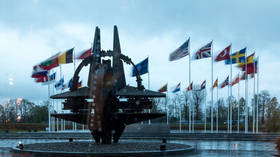Waiting lines at charity kitchens grow longer in US
President Obama is pushing forward plans to double US exports in the next five years, a move that could generate two million jobs amid claims that the country is recovering from the global financial crisis.
The proposal to help America's troubled economy comes as poverty among the working population is at a 50-year high and millions of Americans are still fighting for survival.
New Jersey’s Paterson, more commonly known as Silk City, was once an example of what the industrial revolution looked like in the United States. Now it paints a good picture of what poverty looks like in the US.
In this town, more than 20% are poor and more than 17% are unemployed. It means for many here, 09:00 isn’t the time to go to work – it’s time to head to the food pantry for charity.
“They are low income folks some have been unemployed for almost two years but on average it’s the underemployed,” said Richard Williams of the St. Paul’s Community Development Corp.
They are people who cannot make ends meet and the numbers are only growing. One of them is Jenny, who said “I’m the only one working in the house. It’s just not enough to get all the food we need.”
“We saw in 2009 a 15% increase over 2008 numbers and we are anticipating that number will go up by another 10% at the end of 2010,” Richard Williams added.
Jenny cannot afford to buy food for her mother and three-year-old son. Public assistance is not enough, and she only has a part-time job.
“They don’t need any more hours. I have been looking for jobs and it’s just hard. I’ve been looking everywhere and I can’t find any sending out resumes sending applications and I can’t find any,” said Jenny, whose story is becoming more common not only in Silk City, but also across the entire US.
New statistics for 2009 show 43 million people – or one in seven Americans – are living below the breadline. This is the highest number in more than 50 years when they first began tracking these numbers.
“Opportunities are few and far between, especially in old urban industrial cities,” believes Richard Williams.
And Max Fraad Wolff, an economist at the New School University, says the numbers could be even worse.
“There’s every indication from the data flow that next year will be worse than this year, because the numbers that we are looking at today and in 2009 were already three quarters of the way for 2010 and every trend that made the poverty and the severity of poverty worse last year is very much in place this year,” he said.
And, he added, the fact that “one in seven American adults is living in poverty, and one in just four to five American children, shows us that the sheer numbers and the percentage of Americans who are being systematically failed by the American economy is now in its fourth year of significant increase.”
As in so many other cities in the United States, manufacturing once drove the economy in Silk City. There used to be silk factories that now sit abandoned and decrepit. Signs are everywhere of the jobs that have disappeared or gone overseas.
The closing down of factories left many folk with low skills out in the cold, leading them to line up in their droves for comfort.
Sister Gloria Perez, Executive Director at Eva's Village, says “We now prepare about 1200 meals a day; at noon we’ll be serving about 400 people a free hot lunch.
Some of those who come for a free lunch are the working poor, some are the homeless. All in all, there are 20% more mouths to feed at “Eva’s kitchen” than a year ago. The reason is simple – there is no work right now.
There are those who cannot work due to an incurable disease, like Erwin J. Santana. He complains that “It’s not fair, because I worked hard for some benefits. I used to be a truck driver,” yet he still can’t afford lunch.
And the needy are needier than ever. On the grounds far from Washington and Wall Street, there is no sign of an economic recovery in sight for those unemployed.
They have no thanks for their politicians.
“I don’t know what’s going on in the government. I don’t know what the president is doing. For me it’s not doing better – it’s doing bad,” Erwin J. Santana concluded.












